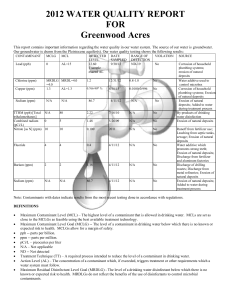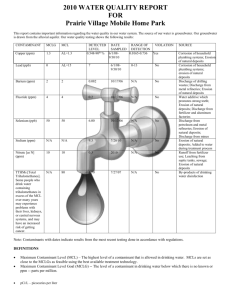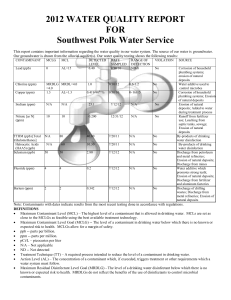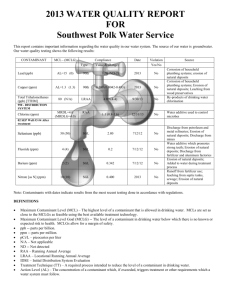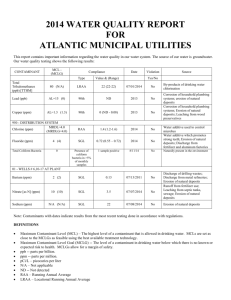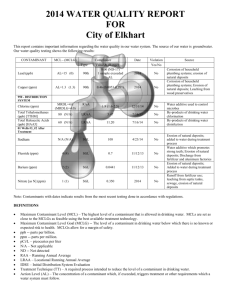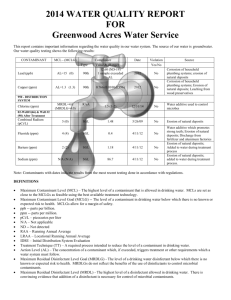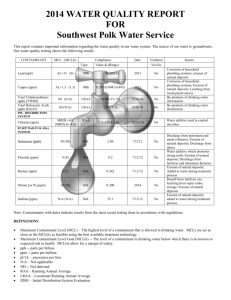consumer confidence report – 2008
advertisement
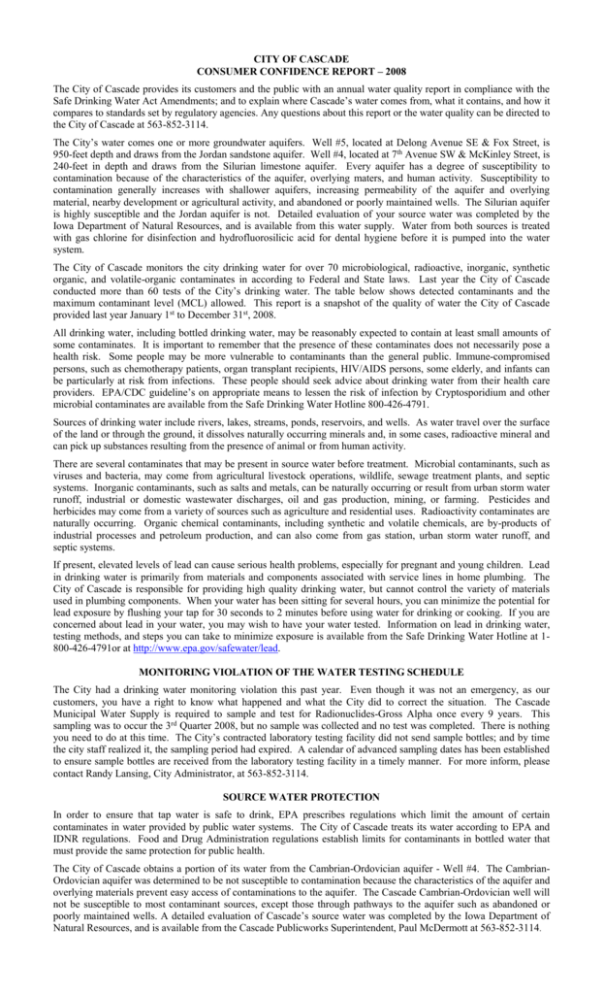
CITY OF CASCADE CONSUMER CONFIDENCE REPORT – 2008 The City of Cascade provides its customers and the public with an annual water quality report in compliance with the Safe Drinking Water Act Amendments; and to explain where Cascade’s water comes from, what it contains, and how it compares to standards set by regulatory agencies. Any questions about this report or the water quality can be directed to the City of Cascade at 563-852-3114. The City’s water comes one or more groundwater aquifers. Well #5, located at Delong Avenue SE & Fox Street, is 950-feet depth and draws from the Jordan sandstone aquifer. Well #4, located at 7th Avenue SW & McKinley Street, is 240-feet in depth and draws from the Silurian limestone aquifer. Every aquifer has a degree of susceptibility to contamination because of the characteristics of the aquifer, overlying maters, and human activity. Susceptibility to contamination generally increases with shallower aquifers, increasing permeability of the aquifer and overlying material, nearby development or agricultural activity, and abandoned or poorly maintained wells. The Silurian aquifer is highly susceptible and the Jordan aquifer is not. Detailed evaluation of your source water was completed by the Iowa Department of Natural Resources, and is available from this water supply. Water from both sources is treated with gas chlorine for disinfection and hydrofluorosilicic acid for dental hygiene before it is pumped into the water system. The City of Cascade monitors the city drinking water for over 70 microbiological, radioactive, inorganic, synthetic organic, and volatile-organic contaminates in according to Federal and State laws. Last year the City of Cascade conducted more than 60 tests of the City’s drinking water. The table below shows detected contaminants and the maximum contaminant level (MCL) allowed. This report is a snapshot of the quality of water the City of Cascade provided last year January 1st to December 31st, 2008. All drinking water, including bottled drinking water, may be reasonably expected to contain at least small amounts of some contaminates. It is important to remember that the presence of these contaminates does not necessarily pose a health risk. Some people may be more vulnerable to contaminants than the general public. Immune-compromised persons, such as chemotherapy patients, organ transplant recipients, HIV/AIDS persons, some elderly, and infants can be particularly at risk from infections. These people should seek advice about drinking water from their health care providers. EPA/CDC guideline’s on appropriate means to lessen the risk of infection by Cryptosporidium and other microbial contaminates are available from the Safe Drinking Water Hotline 800-426-4791. Sources of drinking water include rivers, lakes, streams, ponds, reservoirs, and wells. As water travel over the surface of the land or through the ground, it dissolves naturally occurring minerals and, in some cases, radioactive mineral and can pick up substances resulting from the presence of animal or from human activity. There are several contaminates that may be present in source water before treatment. Microbial contaminants, such as viruses and bacteria, may come from agricultural livestock operations, wildlife, sewage treatment plants, and septic systems. Inorganic contaminants, such as salts and metals, can be naturally occurring or result from urban storm water runoff, industrial or domestic wastewater discharges, oil and gas production, mining, or farming. Pesticides and herbicides may come from a variety of sources such as agriculture and residential uses. Radioactivity contaminates are naturally occurring. Organic chemical contaminants, including synthetic and volatile chemicals, are by-products of industrial processes and petroleum production, and can also come from gas station, urban storm water runoff, and septic systems. If present, elevated levels of lead can cause serious health problems, especially for pregnant and young children. Lead in drinking water is primarily from materials and components associated with service lines in home plumbing. The City of Cascade is responsible for providing high quality drinking water, but cannot control the variety of materials used in plumbing components. When your water has been sitting for several hours, you can minimize the potential for lead exposure by flushing your tap for 30 seconds to 2 minutes before using water for drinking or cooking. If you are concerned about lead in your water, you may wish to have your water tested. Information on lead in drinking water, testing methods, and steps you can take to minimize exposure is available from the Safe Drinking Water Hotline at 1800-426-4791or at http://www.epa.gov/safewater/lead. MONITORING VIOLATION OF THE WATER TESTING SCHEDULE The City had a drinking water monitoring violation this past year. Even though it was not an emergency, as our customers, you have a right to know what happened and what the City did to correct the situation. The Cascade Municipal Water Supply is required to sample and test for Radionuclides-Gross Alpha once every 9 years. This sampling was to occur the 3rd Quarter 2008, but no sample was collected and no test was completed. There is nothing you need to do at this time. The City’s contracted laboratory testing facility did not send sample bottles; and by time the city staff realized it, the sampling period had expired. A calendar of advanced sampling dates has been established to ensure sample bottles are received from the laboratory testing facility in a timely manner. For more inform, please contact Randy Lansing, City Administrator, at 563-852-3114. SOURCE WATER PROTECTION In order to ensure that tap water is safe to drink, EPA prescribes regulations which limit the amount of certain contaminates in water provided by public water systems. The City of Cascade treats its water according to EPA and IDNR regulations. Food and Drug Administration regulations establish limits for contaminants in bottled water that must provide the same protection for public health. The City of Cascade obtains a portion of its water from the Cambrian-Ordovician aquifer - Well #4. The CambrianOrdovician aquifer was determined to be not susceptible to contamination because the characteristics of the aquifer and overlying materials prevent easy access of contaminations to the aquifer. The Cascade Cambrian-Ordovician well will not be susceptible to most contaminant sources, except those through pathways to the aquifer such as abandoned or poorly maintained wells. A detailed evaluation of Cascade’s source water was completed by the Iowa Department of Natural Resources, and is available from the Cascade Publicworks Superintendent, Paul McDermott at 563-852-3114. WATER QUALITY DATA The table below lists drinking water contaminates the City has detected. The presence of contaminants does not necessarily indicate that the water poses a health risk. Some of the data, though representative of the water quality, is more than one year old. The State of Iowa allows the City to monitor for certain contaminants less than once per year because the concentrations of contaminants do not vary significantly from year to year. Nitrate in drinking water at levels above 10 ppm is a health risk for infants under six months of age. High nitrate levels can cause blue baby syndrome. Nitrate levels may rise quickly for short periods because of rainfall or agricultural activity. If you are caring for an infant, ask advice from your health care provider. The City’s water quality testing and monitoring has detected some contaminants. However, none of the contaminants exceeds the Federal and State maximum contaminant level thresholds. The City had no violations, and is proud that its drinking water meets or exceeds all requirements. The EPA has determined Cascade’s water is safe at these levels. Terms & abbreviations used below: Maximum Contaminant Level Goal - The “Goal” (MCLG) is the level of a contaminant in drinking water below which there is no known or expected risk to health. MCLGs allow for a margin of safety. Maximum Contaminant Level - The “Maximum Allowed” (MCL) is the highest level of a contaminant that is allowed in drinking water. MCLs are set as close to the MCLGs as feasible using the best available treatment technology. Action Level - the concentration of a contaminant which, if exceeded, triggers treatment or other requirements which a water system must foll0ow. N/A - not applicable. N/D - not detected limit. Parts per million (ppm) or Milligrams per liter (mg/l) - one part per million corresponds to one minute in two years or a single penny in $10,000. Picocuries per liter (pCi/L) - picocuries per liter is a measure of the radioactivity in water. Parts per billion (ppb) or Micrograms per liter - one part per billion corresponds to one minute in 2,000 years, or a single penny in $10,000,000. TEST RESULTS Contaminant Sample Date(s) Violation Y/N Level Detected MCLG MCL Likely Source of Contamination Barium (ppm) 4-11-05 No .014 2 2 Naturally present in environment. Combined Radium (pCi/L) Coliform Bacteria 4-15-08 No 2.3 0 5 Erosion of natural deposits. 1-1-08 to 12-31-08 No Absent 0 1-1-07 to 12-31-08 6-1-04 to 9-30-06 1-1-08 to 12-31-08 No 4 No .35 lowest 1.8 highest .366 1.3 No Absent 0 Fluoride (ppm) 4-11-05 No .8 4 Lead (ppb) (90th percent) 6-1-04 to 9-30-06 6-1-04 to 9-30-06 1-1-08 to 12-31-08 No 5 0 No 9 0 No 9.2 10 No 1.0 N/A Chlorine (ppm) Copper (ppm) Fecal Coliform & E.coli Lead (ppb) 95th percent) Nitrate (as N) (ppm) Well #4 Radium-226 Presence of Naturally present in the bacteria in 5% of environment. monthly samples 4 Water additive used to control microbes. 1.3 Corrosion of household plumbing, erosion of natural deposits. Sample & repeat Human and animal fecal waste. sample are total coliform, & one is fecal coliform or E.coli. 4 Erosion of natural deposits; water additive for strong teeth; discharge from fertilizers & aluminum mfg. 15 Corrosion of household plumbing, erosion of natural deposits. 15 Corrosion of household plumbing, erosion of natural deposits. 10 Runoff from fertilizer use; leaching from septic tanks, sewage; erosion of natural deposits. N/A Erosion of natural deposits. Sodium (ppm) Well #4 1-7-08 No 9.9 N/A N/A Erosion of natural deposits. Sodium (ppm) Well #5 4-15-08 No 67.9 N/A N/A Erosion of natural deposit. 2,4-D (ppb) 4-1-07 to 3-31-08 No 1.0 79 70 Runoff from herbicide used on row crops.
